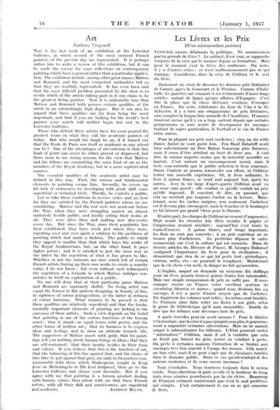Art
Academy Vanguard Tins is the last week of an exhibition at the Leicester Galleries, in which several of the most eminent French painters of the present day are represented. It is perhaps rather late to write a review of this exhibition, but it can be made the excuse for some reflections on contemporary painting which have a general rather than a particular applica- tion. The exhibitors include, among other great names, Matisse and Bonnard, and the most competent authorities tell us that they are worthily represented. It has even been said that the most difficult problem presented by the show is to decide which of the artists taking part in it can claim to be the greatest living painter. Now it is undeniably true that Matisse and Bonnard both possess certain qualities of the artist in an astonishingly high degree. But it can also be argued that these qualities are far from being the most important, and that if you arc looking for the world's best painter your search will neither begin nor end in the Leicester Galleries.
Those who defend these artists have for years poured the greatest scorn on what they call the academic painters of today. But who would the laugh be on, if it turned out that the Ecole de Paris was itself as academic as any school can be ? One of the advantages of art-criticism is that this kind of point can never be either proved or disproved, but there seem to me strong reasons for the. view that Matisse and his felloWs are committing the same kind of sin as the members of the Royal Academy, but in a more sophisticated manner.
The essential qualities of the academic artist may be defined in this way. First, the serious and fundamental elements in painting escape him. Secondly, he covers up his lack of seriousness by developing with great skill some superficial or technical trick. Thirdly, he exploits a public.
Let us take these conditions in reverse order and see how far they are satisfied by the French painters whom we are considering. Matisse and the rest were not academic before the War, when they were struggling against an almost uniformly hostile public, and hardly selling their works at all. They were alive then and making new discoveries every day. But since the War, since their popularity has been established, they have stuck just where they were, repeating over and over again a solution to the problems of painting which had made a fashion. The public to which they appeal is smaller than that which buys the works of the Royal Academicians, but, on the other hand, it pays higher prices ; and it is satisfied in just the same way as the latter by the repetition of what it has grown to like. Whether or not the rumours are true which tell of certain French artists buying up their own works to create a scarcity value, I do not know ; but even without such refinements the repetition of a formula in which Matisse indulges con- stitutes in itself an exploitation of a public.
No one will deny that at their particular game Matisse and Bonnard are supremely skilful. No living artist can equal the former in flat pattern designing, in beauty of line, in rightness of colour juxtaposition; or the latter in richness of colour harmony. What remains to be proved is that these qualities are relatively superficial and that the funda- mentally important elements of painting are lacking in the canvases of these artists. Such a view depends on the belief that painting is one of the serious functions of the human mind ; that it stands on equal terms with poetry and the other forms of written art ; that its business is to express ideas and feelings, and to show an attitude towards life. The supporters of Matisse assert with pride, that his paint- ings tell you nothing about human beings or ideas ; that they are self-contained ; that their beauty resides in their form and colour. If you believe that this is the function of art, that the balancing of this line against that, and the choice of t his blue to put against that grey, are ends in themselves com- mensurable with those which Shakespeare sought in King Lear or Michelangelo in The Last Judgment, then go to the Leicester Galleries and choose your favourite. But if you agree with me that painting is a human product dealing with human values, then admit with me that these French. artists, with all their skill and sensitiveness, are superficial.






































 Previous page
Previous page